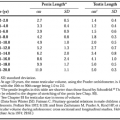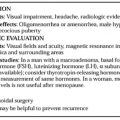CLINICAL MANIFESTATIONS OF GRAVES DISEASE
Part of “CHAPTER 42 – HYPERTHYROIDISM“
The clinical manifestations of Graves disease are myriad and can involve almost any organ system (Table 42-1; Fig. 42-2, Fig. 42-3 and Fig. 42-4).23,24,25,26,27,28,29,30,31,32 and 33 Usually, there is a palpable, diffusely enlarged, smooth goiter that initially may be soft but becomes progressively firmer. Because of the increased vascularity of the gland, there may be a systolic bruit heard with the stethoscope. Patients commonly report nervousness, malaise, irritability, inability to concentrate, hand tremor, weight loss, and burning or itching eyes. Unilateral or bilateral proptosis is frequent, and
vitiligo, pruritus, osteoporosis, and gynecomastia can occur. Choreoathetosis and ataxia are rare presenting signs or symptoms.27 A severe, incapacitating, elephantiasis-like syndrome with pretibial myxedema and acropachy is also seen rarely and may be exacerbated by local trauma (see Fig. 42-3 and Fig. 42-4).28
vitiligo, pruritus, osteoporosis, and gynecomastia can occur. Choreoathetosis and ataxia are rare presenting signs or symptoms.27 A severe, incapacitating, elephantiasis-like syndrome with pretibial myxedema and acropachy is also seen rarely and may be exacerbated by local trauma (see Fig. 42-3 and Fig. 42-4).28
Stay updated, free articles. Join our Telegram channel

Full access? Get Clinical Tree






